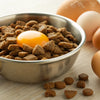Understanding How Much Raw Food to Feed a Dog Per Day
- Houndsy
Table of Contents
- Introduction
- Understanding Dog Nutritional Needs
- Feeding Raw Food to Dogs Throughout Their Life Stages
- Transitioning to a Raw Food Diet
- Monitoring Health and Adjusting Portions
- Conclusion
Introduction
Have you ever wondered why your fur baby looks at you with eager eyes during mealtime? As pet owners, we strive to provide the best for our four-legged friends, including their diet. With the rise in popularity of raw feeding, the question of "how much raw food to feed a dog per day" has become a hot topic in pet care. According to a recent survey, nearly 30% of dog owners have considered switching their pooches to a raw food diet, fueled by claims of healthier coats, increased energy, and fewer vet visits. But how do we determine the ideal portion size without causing unintended consequences?
In this comprehensive guide, we'll delve into the various factors influencing how much raw food is ideal for your dog. From understanding their unique nutritional needs based on age, weight, and activity level to addressing misconceptions about raw feeding, we will tackle this complex question. By the end of this article, you’ll have the knowledge to confidently feed your dog the right amount of nutritious raw food tailored to their specific needs.
We'll explore the foundational principles of raw dog food feeding, guidelines based on different life stages, tips for making the transition, and potential pitfalls to watch for. After reading, we hope you reflect on your current feeding routine and how you can elevate it for the well-being of your furry companion. Whether you're considering the Houndsy Kibble Dispenser for your raw dog food storage (Order Now: https://houndsy.com/products/houndsy-kibble-dispenser) or need to adjust portions, we've got you covered.
Understanding Dog Nutritional Needs
Nutritional Basics for Dogs
Before we jump into raw feeding specifics, it's essential to understand the basics of canine nutrition. Dogs, like humans, require a balanced diet consisting of:
- Proteins: Essential for muscle growth and repair. Sources include raw meat, organ meats, and some seafood.
- Fats: Provide energy and support cell growth. Look for quality fats like fish oil or high-fat meat cuts.
- Carbohydrates: While not essential, they can be a source of energy and nutrients. Consider including cooked grains and certain vegetables.
- Vitamins and Minerals: Found in organ meats and certain vegetables/fruits, these nutrients support overall health.
Given this foundational knowledge, the next step is determining how to convert this into the right quantities.
Factors Affecting Daily Food Portions
Understanding how much raw food to feed your dog requires evaluating several critical factors:
- Weight: Knowing your dog's ideal body weight helps establish a baseline for feeding.
- Age: Puppies require more food relative to their weight compared to adult dogs.
- Activity Level: Active dogs burn more calories and may require larger portions.
- Metabolic Rate: Individual differences can affect calorie requirements; consult with a veterinarian to better understand your dog's needs.
Guidelines and Calculations for Feeding Raw
Various estimates suggest that the percentage of raw food relative to body weight is often the best starting point. The guidelines generally fall within these parameters:
- Adult Dogs: Feed approximately 2-3% of their ideal body weight per day. For example, a 50 lb dog would need about 1 to 1.5 lbs daily.
- Puppies: Require 4-6% of their current body weight per day, as they are rapidly growing. A 10 lb puppy may need up to 0.6 lbs of food.
These percentages can be adjusted based on weight management goals, activity levels, and readiness to transition to a raw diet.
Example Calculation
Let’s say we have a 40 lb adult dog who is moderately active. Using the guidelines:
- 2% of 40 lbs = 0.8 lbs (approximately 12.8 oz)
- 3% of 40 lbs = 1.2 lbs (approximately 19.2 oz)
Thus, we would start by aiming to feed between 0.8 to 1.2 lbs of raw food each day. This can be split into two meals if desired.
Feeding Raw Food to Dogs Throughout Their Life Stages
Feeding Puppies
Puppies are bundles of energy, and their growing bodies need much more nourishment than adult dogs. Here's how to approach raw feeding for puppies:
- Daily Portions: Puppies aged 8 weeks to 4 months should be fed around 4-6% of their current weight daily, divided into 3-4 meals.
- Meal Transition: Ensure to introduce raw food gradually, monitoring for any digestive issues.
For example, if you have a 15 lb puppy, you might start by providing about 6 to 9 oz of raw food every day, spread over multiple feedings.
Feeding Adult Dogs
Once your dog reaches adulthood, the feeding criteria change slightly:
- Portion Control: Adult dogs will generally require 2-3% of their ideal weight for balanced nutrition.
- Adjust for Activity: More active dogs should lean toward the higher percentage, while less active pups can shift towards the lower end.
Feeding Senior Dogs
Senior dogs often have different health and nutritional needs:
- Reduced Portion Sizes: While senior dogs may require slightly less food, focusing on high-quality protein becomes essential to maintain muscle mass.
- Monitoring Weight: Aim for roughly 1.5-2% of their ideal body weight daily, adjusting as needed based on health concerns or weight issues.
Transitioning to a Raw Food Diet
The Shift From Kibble to Raw
Switching from kibble to raw food can be a significant change for both you and your dog. Here are some tips for a successful transition:
- Gradual Change: Begin with a mix of their current kibble and raw food. Transitioning too quickly may disrupt digestion.
- Monitor Reactions: Watch for stool consistency and energy levels. If your dog experiences diarrhea or lethargy, slow the transition and consult with your vet.
- Incorporate Variety: Introduce diverse protein sources like chicken, beef, and fish to provide balanced nutrition and prevent dietary boredom.
The Role of Proper Storage
As you embark on this journey, utilizing high-quality storage solutions like the Houndsy Kibble Dispenser can simplify your life. It helps keep raw food fresh, organized, and easily accessible (Order Now: https://houndsy.com/products/houndsy-kibble-dispenser).
Monitoring Health and Adjusting Portions
Observational Tools
Regular weight and health assessments will help you ensure that your dog remains within a healthy weight range. Keep a close watch on:
- Energy Levels: Is your dog active and playful?
- Coat Condition: A shiny coat often indicates good nutrition.
- Weight Tracking: Use a scale or post-meal observation to assess body condition.
Common Feeding Challenges
1. Weight Loss or Gain: If your dog is losing weight too rapidly or gaining too much, you may need to adjust food portions accordingly.
2. Gut Health: Transitioning to raw can sometimes cause gut disturbances. If your dog consistently has digestive problems, it may be worthwhile to consult a veterinarian.
3. Supplement Needs: In some raw diets, you may need to include additional nutrients such as omega-3 fatty acids or vitamins.
Conclusion
Feeding your dog a raw food diet can be an enriching experience, but navigating how much to feed can be tricky. By understanding your dog's specific needs and using the guidelines we discussed, you can create meal plans that cater to your pet's health and happiness.
As you make the switch, remember that we're here to support you along the way. We encourage you to explore the Houndsy Kibble Dispenser (Order Now: https://houndsy.com/products/houndsy-kibble-dispenser) to help keep your raw meals perfectly portioned and conveniently stored.
Reflect on how your feeding routine may have shaped your dog’s life and consider any changes or enhancements you can make to elevate their dining experience further. And remember, it’s always a good idea to consult your veterinarian during dietary transitions to ensure your dog is receiving all they need for a healthy and vibrant life.
FAQ
1. Is feeding raw food safe for all dogs?
While many dogs thrive on raw diets, some may have health issues that make this unsuitable. Always consult with your veterinarian before making significant diet changes.
2. Can I mix raw food with kibble?
Yes, but be cautious about the digestive impact. Gradually transitioning can help avoid upset stomachs.
3. Will my dog's health improve on a raw diet?
Many dog owners report improvements in energy levels, coat conditions, and overall health after switching. Results vary based on the individual dog.
4. How do I decide the best portion size for my dog?
Use the percentage guidelines discussed and adjust based on activity levels and health monitoring.
5. What if my dog doesn’t like the raw food?
It's okay if some dogs are picky. Experiment with different protein sources and textures, or consider making gradual transitions from cooked to raw.












